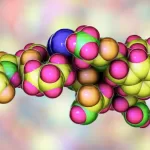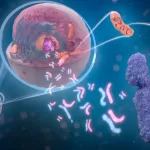A groundbreaking collaboration at the University of Waterloo has led to the development of a new contact lens material designed to act as a bandage for corneal wounds while delivering drugs in a controlled manner to accelerate healing.
Traditionally, patients with corneal abrasions wear clear, oxygen-permeable bandage contact lenses for seven to 10 days, often combined with antibiotic eye drops. However, the challenge lies in ensuring sufficient drug retention on the eye for sustained treatment.
“It’s a targeted-release drug delivery system that is responsive to the body,” explained Dr. Lyndon Jones, a professor at Waterloo’s School of Optometry & Vision Science and director of the Centre for Ocular Research & Education (CORE). “The more injured you are, the more drug gets delivered, which is unique and potentially a game-changer.”
Recognizing the demand for a drug-delivering bandage contact lens, Dr. Jones sought to develop such a product. Through interdisciplinary collaboration at Waterloo, he teamed up with researchers Dr. Susmita Bose, Dr. Chau-Minh Phan, and Dr. Evelyn Yim, an associate professor of chemical engineering specializing in collagen-based materials.
The team also included Dr. Muhammad Rizwan, a former postdoctoral fellow, and John Waylon Tse, a former graduate student, both from Dr. Yim’s lab.
Collagen, a protein naturally present in the eye and involved in the wound healing process, served as the inspiration for the material. Dr. Yim devised a method to strengthen gelatin methacrylate, a collagen derivative, making it ten times stronger.
One key feature of collagen-based materials is their degradation in the presence of an enzyme called matrix metalloproteinase-9 (MMP-9), found naturally in the eye.
“These enzymes are very special because they’re involved in wound healing, and when you have a wound, they’re released in greater quantity,” explained Dr. Phan. “If you have a material that can be degraded in the presence of this enzyme, and we add a drug to this material, we can engineer it so it releases the drug in a way that is proportional to the amount of enzymes present at the wound. So, the bigger the wound, the higher the amount of drug released.”
The team encapsulated bovine lactoferrin, a model wound-healing drug, within the material. In human cell culture studies, they achieved complete wound healing within five days using the novel drug-releasing contact lens material.
Additionally, the material is temperature-sensitive, activating only at eye temperatures, providing a built-in storage mechanism.
The researchers plan to further refine the material, exploring the incorporation of different drugs. They believe their innovation holds promise not only for ocular applications but also for other body sites, particularly large skin ulcers.
Their findings were published in the journal Pharmaceutics, marking a significant advancement in the field of wound healing and drug delivery.












